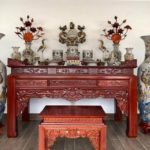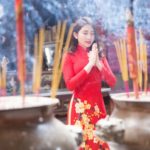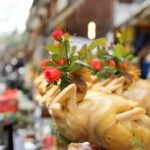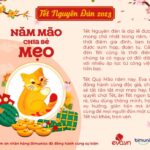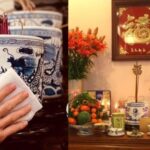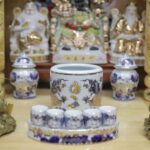The ancestral altar holds a significant place in the cultural fabric of many Vietnamese families, and understanding the intricacies of this tradition is essential. So, how many ancestral altar bowls should there be, and what is their significance? Let’s explore these questions and more in the article below.
1 Unveiling the Significance of the Ancestral Altar Bowl
The act of burning incense is more than just a ritual; it is believed to open a gateway between the living and the deceased ancestors. This makes the ancestral altar bowl the most sacred object on the altar, demanding utmost respect and care.
The Ancestral Altar Bowl on the Buddha Altar
 Understanding the Meaning of the Ancestral Altar Bowl on the Buddha Altar
Understanding the Meaning of the Ancestral Altar Bowl on the Buddha Altar
The Buddha altar typically features a single ancestral altar bowl, symbolizing sincere respect for the Buddha and a plea for his blessings. It is a way to seek his understanding and pray for peace for all beings.
The Ancestral Altar Bowl in Ancestral Worship
When it comes to ancestral altars, the bowl takes on a deeper meaning. It symbolizes the sincerity of the family members towards the guardian deities of the house. The more earnest the homeowner is in their devotion, the more protection and blessings they are believed to receive from these deities.
 Exploring the Meaning of the Ancestral Altar Bowl in Ancestral Worship
Exploring the Meaning of the Ancestral Altar Bowl in Ancestral Worship
Additionally, the ancestral altar bowl serves as a reminder to descendants of their roots and a way to express gratitude to their ancestors. This tradition instills moral character and gratitude in younger generations, making it a cherished practice across the nation.
2 Unraveling the Deities of the Ancestral Altar
 Discovering Who is Worshipped on the Ancestral Altar
Discovering Who is Worshipped on the Ancestral Altar
Diving into traditional beliefs, we find that the ancestral altar is divided into three distinct levels, each with its own significance:
- Buddha Worship: Families often set up a Buddha altar to invoke peace and seek resolution for misfortunes, guiding them towards Nirvana.
- Deity Worship: Deities such as the Earth God, Dragon Vein, God of Wealth and Fortune, and former and current landowners are worshipped for their protective role over the family’s peace.
- Ancestral Worship: This level is dedicated to deceased relatives and close members of the family and clan, who are believed to provide protection and support in all aspects of life.
3 Determining the Ideal Number of Ancestral Altar Bowls
The Single Ancestral Altar Bowl
 Understanding the Significance of an Altar with One Ancestral Bowl
Understanding the Significance of an Altar with One Ancestral Bowl
Young families often start with a single ancestral altar bowl, worshipping deities, the Earth God, and their ancestors together. However, this setup may indicate that the homeowner doesn’t place a strong emphasis on worship, perhaps due to their new or transitional living situation.
The Duo of Ancestral Altar Bowls
 Exploring the Standard Practice of Two Ancestral Altar Bowls
Exploring the Standard Practice of Two Ancestral Altar Bowls
According to Eastern culture’s standard worship practices, having at least two ancestral altar bowls is ideal. One bowl is dedicated to the Buddha altar, while the other serves the deities and ancestors. This arrangement is similar to the one-bowl altar but includes a Buddha altar placed above, signifying respect and devotion.
It’s important to note that the two bowls should be placed at different levels, with the Buddha altar bowl typically on top, creating a sense of hierarchy and reverence.
The Trio of Ancestral Altar Bowls
 Unlocking the Luck of Three Ancestral Altar Bowls
Unlocking the Luck of Three Ancestral Altar Bowls
Arranging three ancestral altar bowls is believed to bring more luck to the homeowner. The number three symbolizes the three levels of the altar, ensuring that when the homeowner invites the deities and ancestors into their home, each level is represented by a separate bowl, creating a harmonious and distinct space for each deity.
The Quartet of Ancestral Altar Bowls
 Understanding the Setup and Worship Practices for Four Ancestral Altar Bowls
Understanding the Setup and Worship Practices for Four Ancestral Altar Bowls
The four-bowl arrangement is similar to the trio setup but includes a Buddha altar on top. However, it’s crucial to remember that the Buddha altar should always be the first to receive incense and prayers, maintaining its primacy in the worship ritual.
The Quintet of Ancestral Altar Bowls
 Exploring the Rarity of Five Ancestral Altar Bowls
Exploring the Rarity of Five Ancestral Altar Bowls
In Vietnam, finding an altar with five ancestral altar bowls is quite uncommon. This arrangement is typically found in families where both the husband and wife are firstborns in their respective families. The five bowls cater to specific worship needs:
- One central bowl is dedicated to worshipping deities and the Earth God, the guardians of peace and prosperity.
- Two bowls on the right honor the paternal Manh and Co, paying respect to the ancestors on the father’s side.
- Two bowls on the left are reserved for the maternal Manh and Co, acknowledging the ancestors on the mother’s side.
However, for convenience in worship practices, it is recommended to separate these five bowls into two or three altars, as having all five on one altar is more common in large-scale clan temples.
We hope that this article has illuminated the significance of the ancestral altar and its proper arrangement. May your home always be filled with the blessings of your ancestors and the deities they hold dear.

























